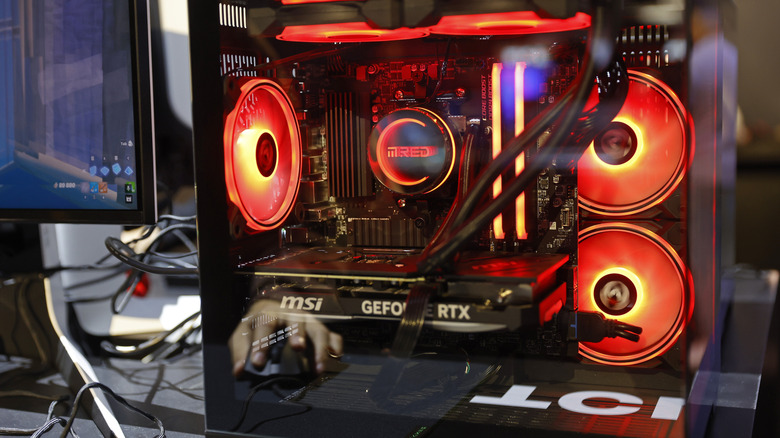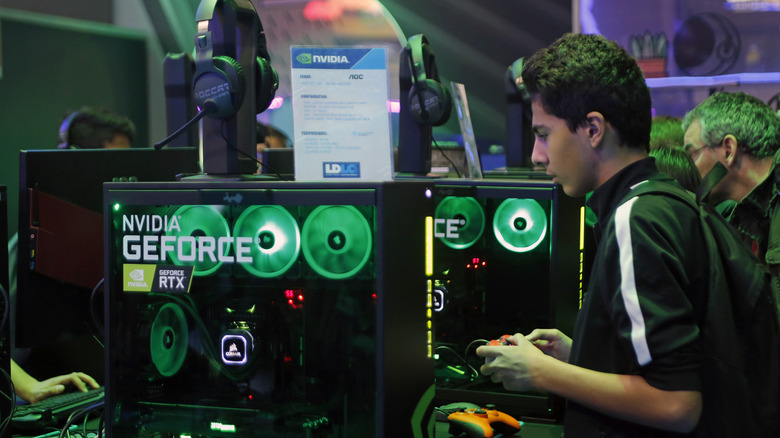What Does 'VRAM' Actually Mean On An Nvidia GPU?
We may receive a commission on purchases made from links.
When it comes to acronym overabundance, Nvidia's computer peripherals are a chief offender. We've already talked about what "RTX" means on an Nvidia graphics card — as well as what "DLSS" means on an Nvidia GPU — but if you've been looking into upgrading your stock GPU with a new Nvidia model, you may be wondering what "VRAM" refers to. The simple answer is "video random-access memory," a type of memory used to store image data for a PC display.
You'll see those four letters pop up a lot when talking about graphics cards because VRAM is heavily tied to gaming performance. Modern PC titles rely on enormous amounts of visual data to render complex scenes in real time. Think polygon-based 3D subjects, texture layers, shaders, particle effects, and everything else that makes a digital world feel alive on screen. And the more VRAM your GPU has, the more efficient it will be at rendering high-resolution visuals without frame drop or stuttering.
Nvidia is a market leader for GPUs, but VRAM isn't exclusive to the brand — you'll find it on competitive graphics cards from the likes of AMD and Intel, too. There's plenty more to learn about VRAM, so let's dive deeper into the world of GPU circuitry.
How much VRAM do you need?
The origins of VRAM can be traced back to 1980, when three IBM employees — Frederick Dill, Daniel Ling, and Richard Matick — invented the allocated memory for use in a high-resolution graphics adapter for the RISC Technology Personal Computer (RT PC). A type of dynamic memory (DRAM) that acts as a bridge between the CPU and display, VRAM transmits data to a monitor using connections like HDMI and VGA.
Most modern GPUs use a class of VRAM known as Graphics Double Data Rate, sixth-generation, or GDDR6 as it's more commonly known. Built for heavy graphics workloads, GDDR6-class VRAM is all about bandwidth. It doesn't worry much about saving power or keeping clock speeds modest — it's designed to blast enormous chunks of visual data to the GPU as fast as possible. When a modern game is cranked to Ultra settings and still looks stunning while running smoothly, there's a good chance GDDR6 is the memory making sure all those textures, lighting effects, and shader passes show up exactly when they're needed.
So, how much VRAM does one need exactly? That all depends on what you're tasking your GPU with. If you're more about browsing the web, watching HD videos, and light gaming now and then, 4 to 8GB should more than do the trick. But if you're planning on taking advantage of 4K visuals for gaming or graphics-focused projects, you should have at least 16GB of VRAM, or more.
VRAM: The key to smooth, high-quality graphics
GPU tech moves fast, and we're already seeing companies like Nvidia release graphics cards built on GDDR7 memory. This new generation of VRAM boosts bandwidth for even cleaner, more detailed visuals, while also powering the latest wave of AI-assisted image tuning and performance optimization. But for now, GDDR6 remains the most widely used form of VRAM, and current mainstream GPUs — like AMD's Radeon RX 9070 —show just how capable this memory standard remains when it comes to delivering smooth, high-resolution gameplay.
Still, it probably won't be much longer until GDDR7 rules the roost. The TL;DR on all this VRAM conversation: Without VRAM, PC games and graphics-oriented software would run pretty poorly. Without enough VRAM, your system RAM has to pick up the slack, and that employee isn't as well-trained at delivering big batches of bytes quickly. When today's PC games are firing on all cylinders, the results can look stunning, and VRAM is essential to delivering that level of performance and visual fidelity. Want to unpack another acronym with us? Check out our explainer on what "FG" or "MFG" on an Nvidia graphics card actually means.


